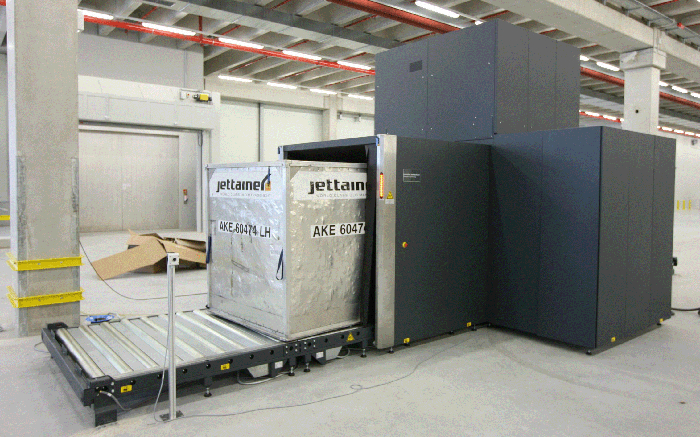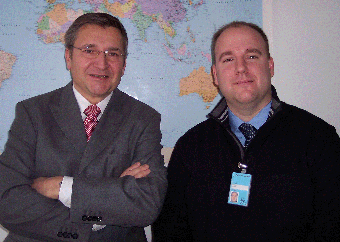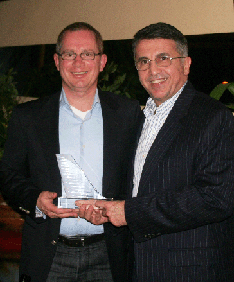Security Top Priority At Lufthansa

 How
well is the air freight industry prepared to meet the requirements of
Washington’s Transportation Security Administration (TSA) for
a 100% screening of shipments flying on passenger aircraft beginning
next August? How
well is the air freight industry prepared to meet the requirements of
Washington’s Transportation Security Administration (TSA) for
a 100% screening of shipments flying on passenger aircraft beginning
next August?
“We are,” claim Lufthansa
Cargo’s security experts in photo Harald Zielinski (left) and
Jim (James) LoBello (right) simultaneously. All seventeen U.S. airports
the airline is landing at are equipped with self-owned trace detection
devices or x-ray screening machines. The choice between explosive ‘sniffers’
or x-ray machines is optional and is contingent on a number of factors.
TSA’s Certified Cargo Screening Program
(CCSP) and related air carrier security programs accept both techniques,
emphasizes New York-based Jim LoBello, Head of Security, the Americas
at Lufthansa Cargo.
“We are actively planning for August
by building up resources, applying increased training, redesigning processes,
conducting industry outreach and integrating additional equipment into
the operation at our stations.”
The German carrier’s Chief Security
Manager and Head of Risk Prevention Management Harald Zielinski complemented
his statement.
“Despite any cost cutting programs
we keep spending heavily for enhancing the security at our numerous
stations worldwide. This adds up to a “high, double-digit million
euros sum per year,” states Harald.
The consequences are twofold: First,
thanks to the many cameras installed within Lufthansa Cargo’s
warehouses, the fencing in of facilities, access limitations for truckers
and non-authorized and unregistered personnel as well as intense controls
of the ground handling staff, fraud of shipments is hardly a topic any
longer. Secondly the offering of utmost security to agents and shippers
becomes a major selling point that promotes the carrier’s positive
image further of being a secure and reliable airline—investments
that could pay off at the end of the day.
Presently LH Cargo charges dollars 0.05
per kilogram for all screening services in the U.S. However, Harald
and Jim are highly convinced that air freight security will gradually
become more expensive for the clients because of the growing efforts
demanded by the national authorities from the carriers. Take one big
x-ray machine that costs well over one hundred thousand euros. For operating
it 24 hours, 7 days a week it needs at least fourteen well trained and
skilled staff that work in three or more shifts.
“Regulations increase. So security
is getting more important and costly,” says Harald.
In the U.S. all intercontinental freighter
gateways LH Cargo is serving – JFK, ORD, ATL, DFW and LAX, meanwhile
will be equipped with big x-ray machines that have the capability to
screen entire air freight LD 3 containers, under certain conditions,
for lower deck transports on passenger aircraft.
“When it comes to baseline security
and screening or sniffing practices we don’t make any difference
between shipments that are flown on board of passenger aircraft or freighters,”
emphasizes Jim. He questions TSA’s position that mandates 100%
screening only for cargo transported in the belly-hold compartments
of passenger aircraft beginning this August.
Worldwide, LH Cargo is integrating a growing
number of airports in its net of so called ‘premium security stations’.
Presently included are Frankfurt’s two cargo cities north and
south, further Munich, Shanghai, New York (JFK), Chicago, Dallas, Los
Angeles, Mexico City, Johannesburg, Milan, Amsterdam, and Istanbul.
In the current year five more airports will
be added, announces Herr Zielinski, namely Toronto and Shenzhen with
the other three still having to be selected. When it comes to security
“we are very pro-active, informing shippers and agents in local
meetings about the latest requirements, organize awareness programs
and coach our staff to sharpen their understanding,” claims Harald.
This includes yearly security conferences
in either New York or Frankfurt with high ranking security experts delivering
newest insights. Next meeting will be held February 2, at Lufthansa
Corporate headquarters in East Meadow, Long Island. There, thrilling
topics like “Risk Faced by the Aviation Industry, Threats that
will continue to evolve,” or “Changing dynamics of security
in the supply chain, the threat of HME & advanced explosives”
are standing on the agenda.
Frankfurt is to follow March 4, featuring
mainly European topics and discussing how to best bring security regulations
and expectations between Brussels and Washington in line. The Lufthansa
Cargo security meetings are free of charge, but can be attended by invitation
only.
“As global market leader in air
freight security matters we feel obliged to bring hand-picked experts
from academies, the industry, authorities and the media together to
deliver facts and better the participant’s knowledge,” states
Herr Zielinski. His airline is the only cargo carrier that offers these
insights to a selected public.
Heiner Siegmund
|




